There’s nothing like the thrill of waking up to crisp air and breathtaking views in the great outdoors. But with adventure comes responsibility—especially when you’re miles from civilization. I learned this the hard way during a Sierra Nevada trip when sudden storms turned a peaceful hike into a race against time.
Today, more people than ever are embracing the outdoors. Over 3.4 million U.S. households started camping recently, and a third plan trips a month ahead (KOA data). Whether you’re a seasoned explorer or a first-timer, preparation is key. That’s why I’ve crafted the Explorer’s Checklist—10 must-have systems to keep you safe and confident in the wild.
Table of Contents
Key Takeaways
- Adventure in the great outdoors requires careful planning.
- Weather can change fast—always be prepared.
- Over 3 million new households have taken up camping.
- Advanced trip planning boosts safety and enjoyment.
- Follow a proven checklist for wilderness success.
1. Understanding the Importance of Mountain Camping Safety
My near-disaster at dusk in Wyoming taught me more about preparedness than any guidebook. I’d underestimated daylight by an hour—racing to pitch my tent as shadows swallowed the valley. That scramble was a wake-up call: nature doesn’t accommodate mistakes.
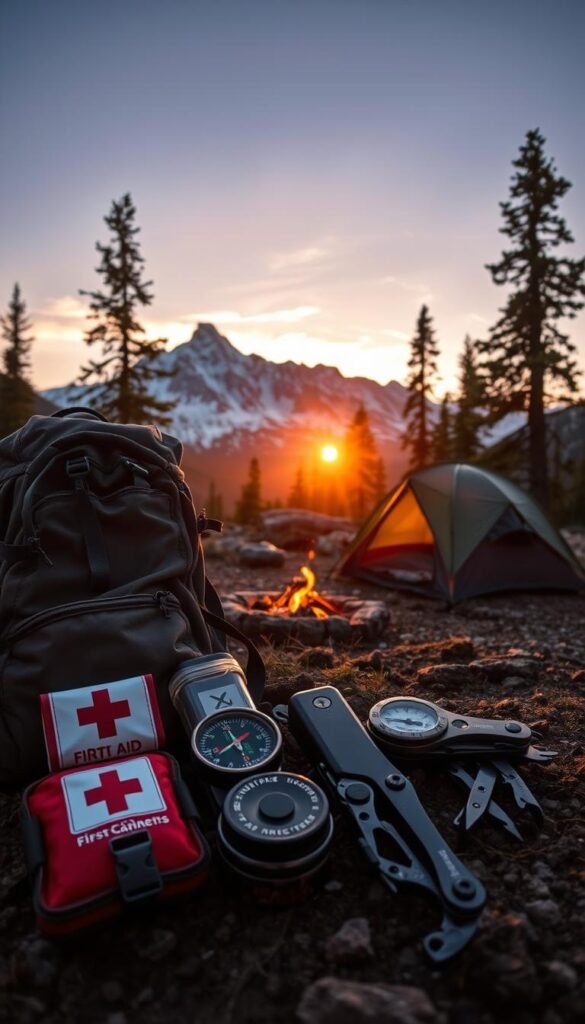
Why Safety Should Be Your Top Priority
National Park Service reports reveal harsh truths: 42% of injuries stem from falls, while 23% result from weather exposure. Your body reacts unpredictably at altitude too. Dehydration escalates in three stages:
- Mild: Dry mouth, fatigue
- Moderate: Dizziness, rapid heartbeat
- Severe: Confusion, collapse
Pack electrolytes—I learned this after a grueling hike left me dizzy at 10,000 feet.
Common Risks in Mountain Camping
Food poisoning affects 1 in 6 Americans annually, per KOA research. Store meals properly, and use 60% alcohol sanitizer after wildlife contact. Bears? Frontcountry encounters are rare (1 in 232,000), but backcountry odds spike—always carry bear spray.
Plan like your trip depends on it. Because it does.
2. Choosing the Right Shelter and Campsite
The crunch of gravel underfoot signaled my arrival at what I thought was the perfect campsite—until sunset revealed its hidden dangers. A shallow dip in the land became a riverbed during a midnight storm. Now, I always scout with three questions: Will this spot stay dry? Is it shielded from wind? Are there overhead hazards?
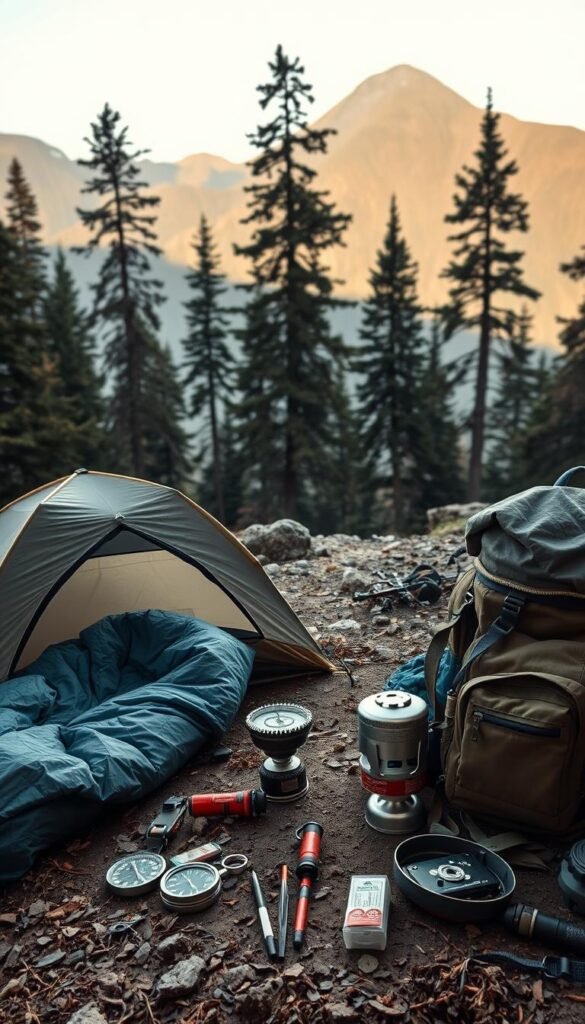
Evaluating Your Needs: Tent vs. Cabin vs. RV
Sixty percent of adventurers prefer tents (KOA data), but cabins and RVs offer unique advantages. Here’s how they stack up:
- Tents: Lightweight (like the 1-pound Zpacks Duplex) but require skill to weather storms. Four-season models handle snow but lack insulation.
- Cabins: Built-in heat and walls—ideal for families. KOA sites often include kitchens, but you’re tied to one location.
- RVs: Mobility with beds. Always use chock blocks on slopes and test CO detectors monthly.
Selecting a Safe and Suitable Location
Yellowstone taught me to avoid floodplains. The National Park Service recommends:
- 15-foot clearance from fire pits to tents or trees.
- Check for dead branches using the USFS “Wise Owl” guide—look for cracks or missing bark.
For multi-day trips, study topographic maps and plan your route carefully. A well-chosen site turns a good trip into a great one—like my favorite ridge spot in Colorado, where dawn light spills over the valleys.
Learn more about planning a multi-day backpacking excursion to refine your location strategy.
3. Staying Informed About Mountain Weather
Weather forecasts said ‘sunny’—but at 11,000 feet, forecasts are more like gentle suggestions. I learned this when a rogue thunderstorm ambushed my group in Colorado’s San Juans. Now, I triple-check NOAA’s Mountain Zone Forecast System, which breaks down elevation-specific conditions.
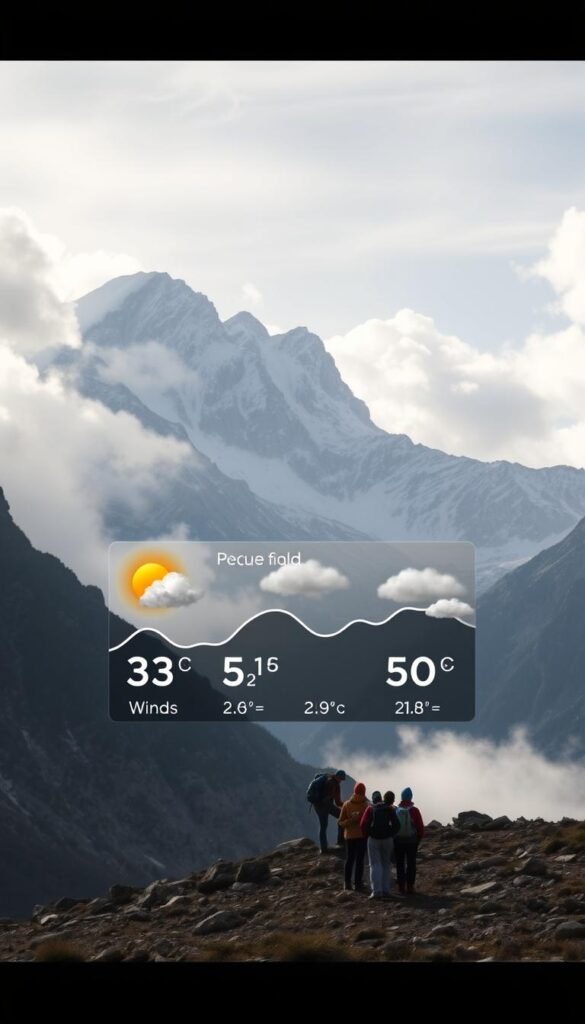
How to Check and Interpret Weather Forecasts
Alpine regions use METAR codes—aviation shorthand for weather. Here’s a cheat sheet:
- SKC: Sky clear (but still pack a rain jacket).
- BKN030: Broken clouds at 3,000 feet (expect wind).
- +SHRA: Heavy showers (time to hunker down).
KOA recommends a 3–5 day water reserve. I stash an extra liter per person after a hailstorm stranded me overnight.
Packing for Inclement Weather Conditions
Layering is everything. My go-to combo:
| Layer | Material | When to Use |
|---|---|---|
| Base | Patagonia Capilene | Wicks sweat in all conditions |
| Mid | Fleece or down | Below 40°F or windy |
| Shell | Gore-Tex or eVent | Rain/snow protection |
For emergencies, practice the bivouac technique: Wrap yourself in a space blanket under your tent’s rainfly. It saved me during a White Mountain hailstorm when visibility dropped to zero.
Pro tip: UV radiation spikes 10% every 1,000 feet. At 8,000 feet, SPF 30 acts like SPF 15—reapply hourly.
4. Packing and Storing Food Safely
The smell of fresh guacamole turned my Gila Wilderness trip into a lesson in food safety I’ll never forget. By noon, the creamy dip had attracted every ant in a five-mile radius—forcing us to abandon half our meals. Now, I treat food storage like a survival skill.

Preventing Wildlife Encounters
Bears aren’t the only threat. Raccoons and mice can chew through tents for a snack. Make sure to:
- Use a counterbalance hang system—14 feet high, 6 feet from the trunk (4:1 pulley ratio works best).
- Test odor-proof bags: OPSAKs block smells for 5 days; LOKSAKs resist punctures but weigh more.
- Choose bear canisters like BearVault (97% effective) over Ursacks in high-traffic areas.
Avoiding Food-Borne Illnesses
USDA wilderness guidelines state perishables last just 4 hours above 40°F. Help ensure safety with this table:
| Food Type | Storage Method | Max Safe Temp |
|---|---|---|
| Dairy | Insulated cooler + ice | 34°F |
| Meats | Vacuum-sealed + freeze | 28°F |
| Dry goods | Silica gel packs | Room temp |
Probiotics like Seed Daily Synbiotic can stabilize digestion—I pack them for multi-day trips. For more food storage ideas, check weather trends and plan meals accordingly.
5. Practicing Campfire Safety
The crackle of flames under a starry sky is magical—until wind shifts turn your cozy fire into a runaway blaze. I learned this during a trip to Utah’s backcountry, where a gust sent embers flying toward parched grass. Now, I treat every fire like a potential emergency, with strict protocols from setup to extinguishing.
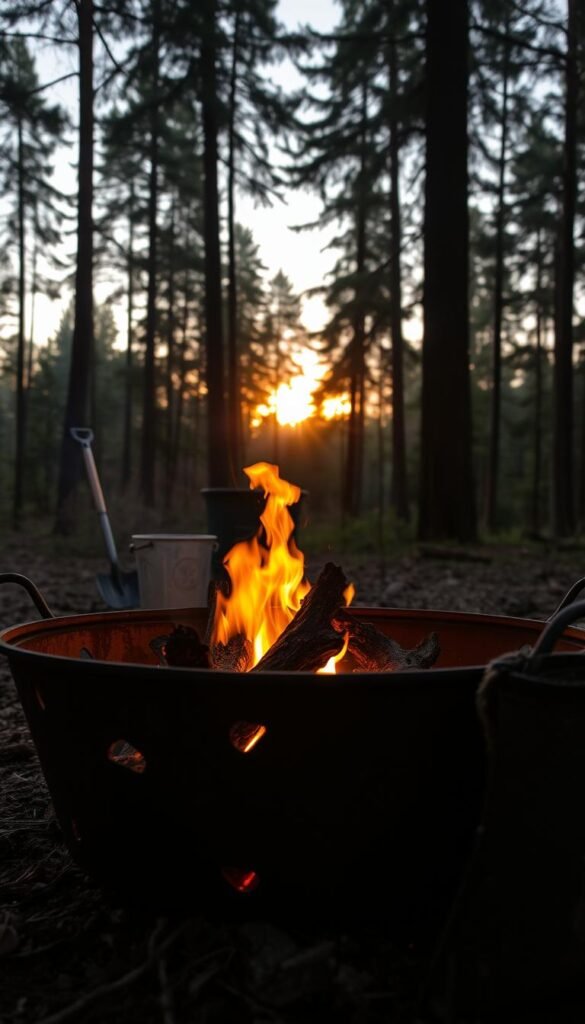
Setting Up a Safe Fire Pit
Use the Dakota fire hole method: Dig a 12-inch-deep pit with a smaller air tunnel. This design burns efficiently and contains sparks. Always follow KOA’s 15-feet clearance rule—no flames near tents, trees, or dry brush.
Firestarters matter too. Fatwood ignites faster than cotton balls but burns shorter. For windy conditions, pack waterproof matches and a ferro rod as backup.
Extinguishing Fires Properly
Smokey Bear’s “Drown, Stir, Feel” method works:
- Pour water until hissing stops.
- Stir ashes to expose hidden embers.
- Test warmth with the back of your hand—repeat if needed.
Yosemite’s 2022 wildfires traced to poorly extinguished fires. Scatter cold ashes widely, following Leave No Trace principles. A little effort prevents disasters.
6. Protecting Yourself from Insects and Allergies
Allergies hit me like a freight train at 8,000 feet—my throat swelled shut before I could even say “epinephrine.” That moment taught me wilderness allergies aren’t just inconvenient; they’re life-threatening. Now, I treat bug bites and pollen like potential emergencies.
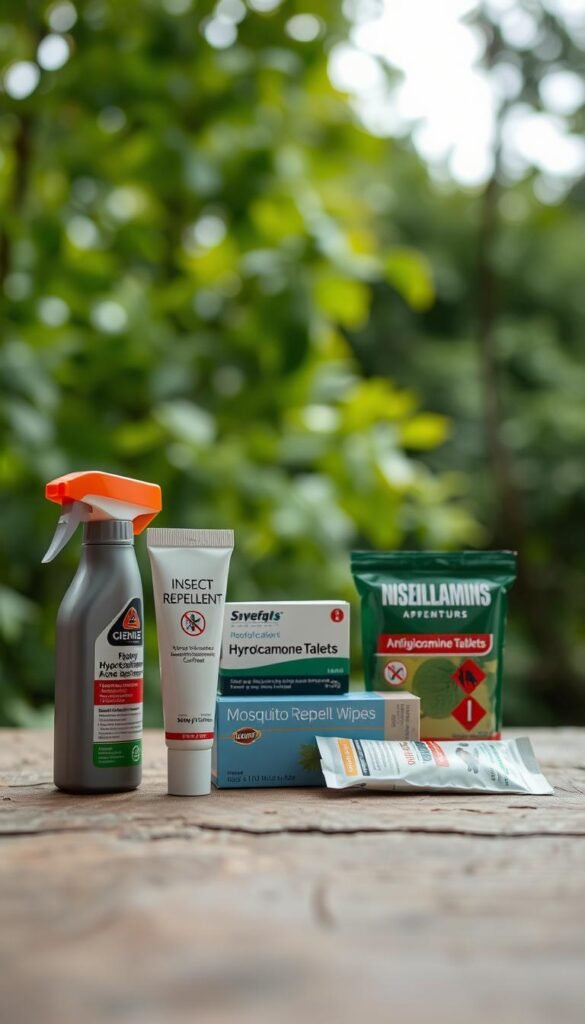
Effective Insect Repellent Strategies
DEET or picaridin? The CDC backs both, but permethrin-treated clothes are the real game-changer. Here’s how they compare:
- DEET (25–30%): Lasts 8 hours but melts plastic gear. I ruined a headlamp learning this.
- Picaridin (20%): Odorless and gentle on gear—ideal for kids.
- Natural oils: Lemon eucalyptus works… until sweat washes it off in 90 minutes.
For ticks, skip the match trick. Use Tick Key tools—slide under the head and twist. Clean the bite with alcohol wipes from your first aid kit.
Managing Allergies in the Wilderness
My epinephrine autoinjector failed at 12,000 feet—the cold killed the mechanism. Now I pack two, insulated in socks. Altitude worsens reactions; antihistamines like Benadryl need dosage adjustments:
- Below 5,000 ft: Standard dose (25mg every 6 hours).
- 5,000–10,000 ft: Increase by 10% (27.5mg).
- Above 10,000 ft: Add 20% (30mg) and monitor dizziness.
To stay safe, always check weather for pollen counts. Dawn and dusk are peak bug hours—plan hikes accordingly. And that hat? It shields from both sun and swarms.
7. Shielding Your Skin from the Sun
Sunburn at 10,000 feet feels like a branding iron—I learned this the hard way during a Rockies trek. UV radiation spikes 4% every 1,000 feet, meaning at alpine elevations, even cloudy days deliver harsh exposure. KOA recommends SPF 15 minimum, but I now swear by SPF 50+ after blistering my shoulders in Colorado.
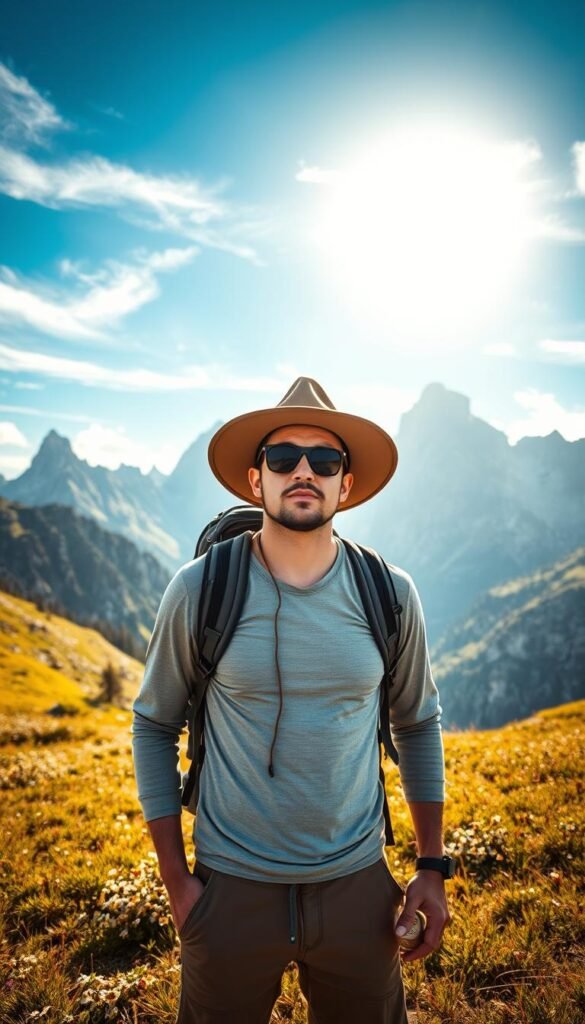
Understanding UV Risks in the Mountains
Calculate exposure using this elevation/cloud cover matrix:
| Elevation | Clear Sky | Partial Clouds |
|---|---|---|
| 5,000 ft | UV 8 (Very High) | UV 6 (High) |
| 10,000 ft | UV 12 (Extreme) | UV 9 (Very High) |
Zinc oxide saved a melanoma survivor I met—she applies it like war paint, covering ears and neck crevices. Sunglasses? ANSI Z80.3 blocks 99% of UVA/UVB. Lesser lenses risk retinal burns.
Choosing the Right Sun Protection
UPF clothing outperforms sunscreen. Compare top brands:
| Brand | UPF Rating | Best For |
|---|---|---|
| Coolibar | 50+ | All-day coverage |
| Columbia PFG | 30 | Breathability |
A hat with a 3-inch brim shades your face better than any lotion. For cooling, soak a bandana in water and tie it loosely—evaporation lowers skin temp by 10°F. My go-to move during Arizona treks.
This experience reshaped my routine: sun protection isn’t optional at altitude. It’s survival.
8. Staying Hydrated in High Altitudes
Altitude doesn’t just steal your breath; it steals your water—something I realized halfway up a Colorado 14er with no streams in sight. At elevation, your body loses fluids twice as fast through sweat and respiration. The National Park Service’s urine color chart became my bible: pale yellow means you’re winning; amber signals trouble.

Recognizing Dehydration Symptoms
Early signs are subtle. A dry mouth escalates to dizziness, then confusion—like my Canyonlands ordeal where kidney stones formed from chronic dehydration. Make sure to watch for:
- Stage 1: Thirst, fatigue (drink 1.5L extra daily above 8,000 ft).
- Stage 2: Dark urine, headaches (add electrolytes).
- Stage 3: Rapid heartbeat, collapse (seek shade immediately).
Hydrating foods like cucumbers and melons help, but avoid alcohol—it’s a diuretic that worsens dehydration.
Emergency Water Supply Tips
When streams vanish, get creative. Conifer transpiration bags yield 1L/day—strap them to pine branches at dawn. For deserts, solar stills distill groundwater using plastic sheets and rocks.
Filters are lifelines. Compare these:
| Brand | Flow Rate | Best For |
|---|---|---|
| Katadyn Hiker | 1L/min | Groups |
| Sawyer Squeeze | 1.7L/min | Solo speed |
Stay safe by balancing electrolytes: 500mg sodium and 200mg potassium per liter during exertion. Time it right—sip every 15 minutes, don’t chug.
9. Handling Wildlife Encounters
A rustling in the bushes froze me mid-step—my pulse hammered as I realized I wasn’t alone in Montana’s backcountry. Wildlife encounters are equal parts thrilling and perilous. Proper preparation can turn a potential emergency into a memorable story.
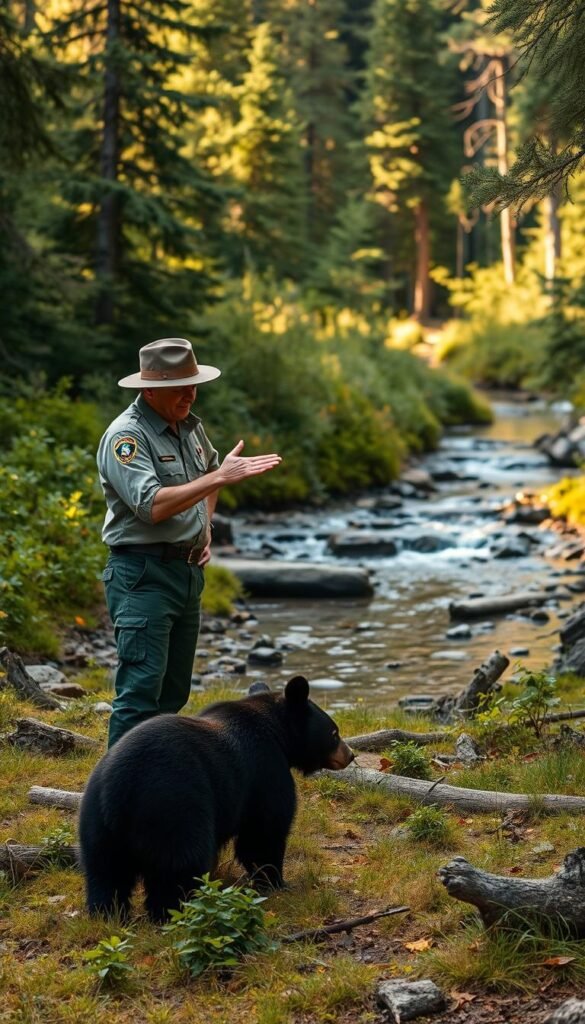
Safe Food Storage Practices
USFS regulations require secure trash cans and odor-proof containers. I use the bear triangle method:
- Cooking area: 100 yards downwind from tents.
- Food storage: Hung 12 feet high between two trees.
- Sleeping zone: Upwind, with bear spray accessible.
Yellowstone data shows bear spray stops attacks 90% of the time—far more effective than guns. Store it holstered, not buried in your pack.
What to Do If You Encounter Wildlife
Grizzlies may bluff charge. Stand your ground and shout—their decibel threshold is 120dB (air horns hit 130dB). For moose, watch for pinned ears or raised hackles. Back away slowly; never run.
Learn more about avoiding wild animal encounters to help ensure your next trip stays safe. Remember: wildlife respects distance, not dominance.
10. Conclusion: Enjoying Your Adventure Responsibly
Staring at the Milky Way from Arizona’s desert taught me more about silence than any meditation app ever could. That night, under a tapestry of stars, I grasped the Appalachian Trail’s stewardship philosophy—leave it better than you found it.
The NPS’s seven principles aren’t rules; they’re a pact with the wild. I now pack out trash others leave behind and use KOA’s 500 locations as gateways to low-impact trips. Their resources help anyone explore wisely.
Embrace shinrin-yoku—the Japanese practice of absorbing the forest’s calm. Let pines whisper lessons in resilience. The great outdoors rewards those who tread lightly and listen deeply.
Adventure isn’t just about peaks conquered. It’s about the experience of belonging to something vast. Go forth—but always with care.

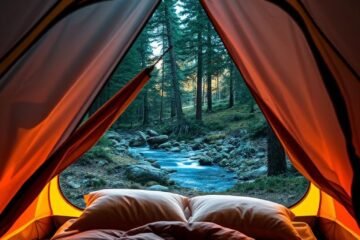

0 Comments